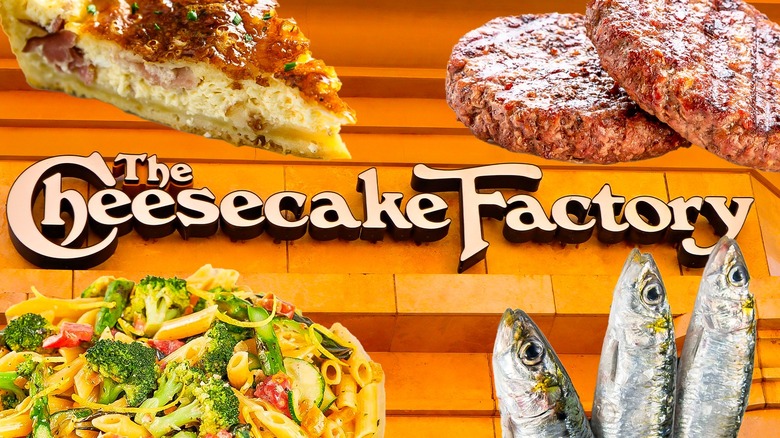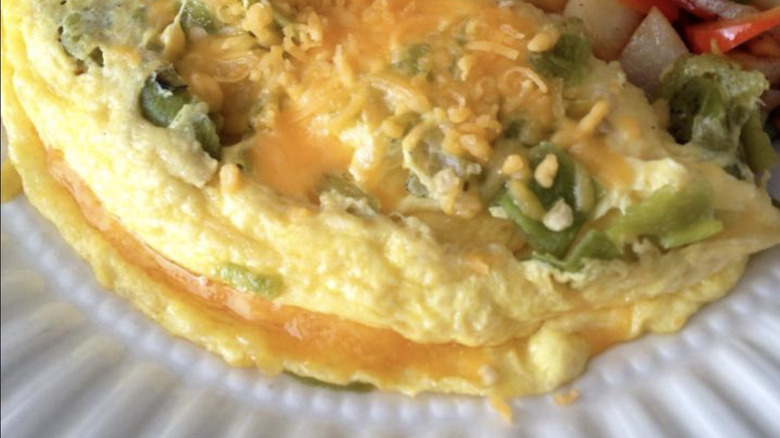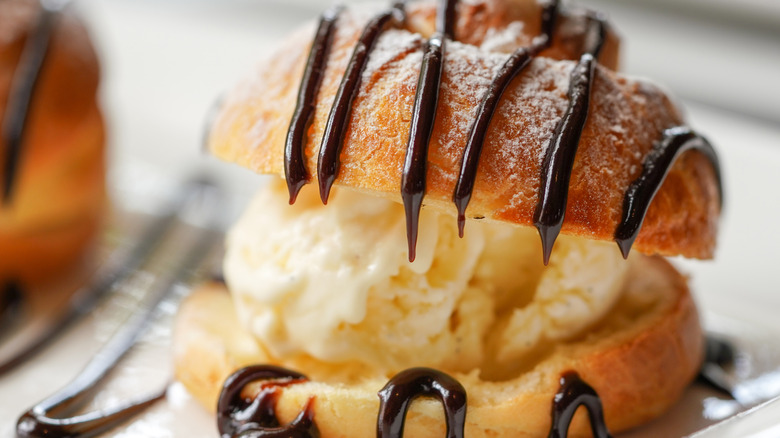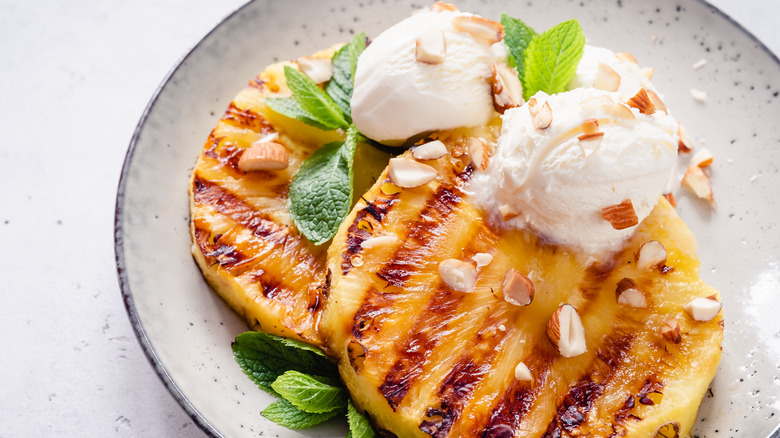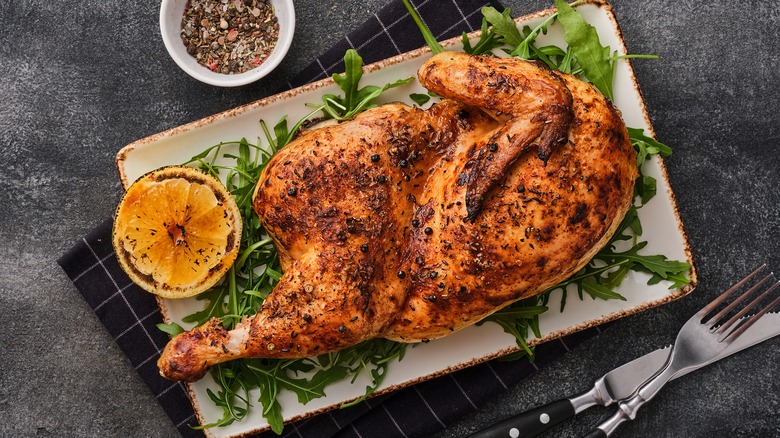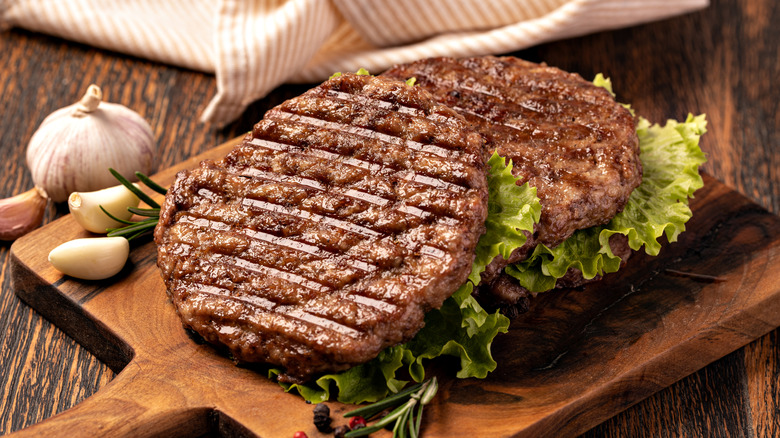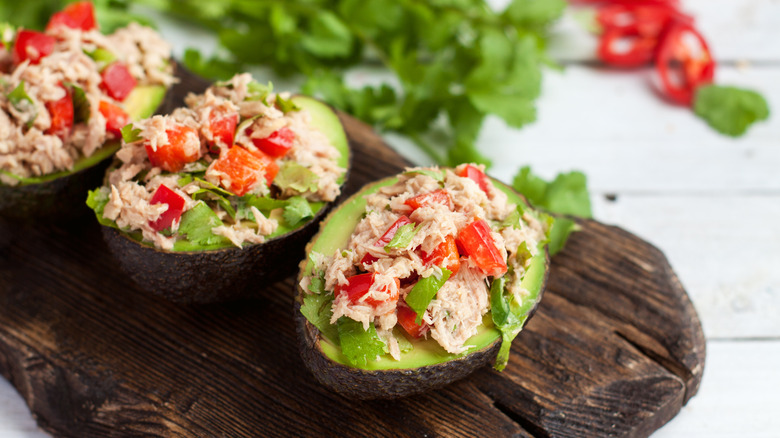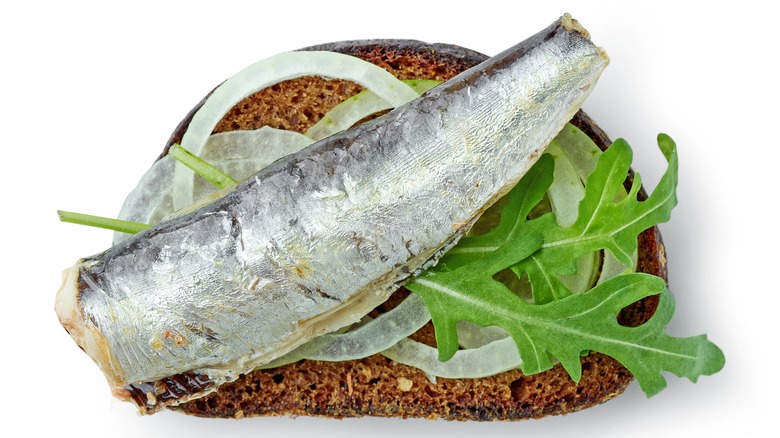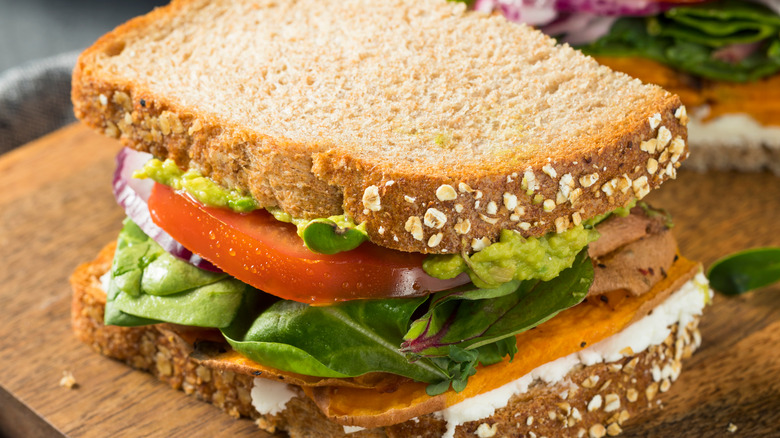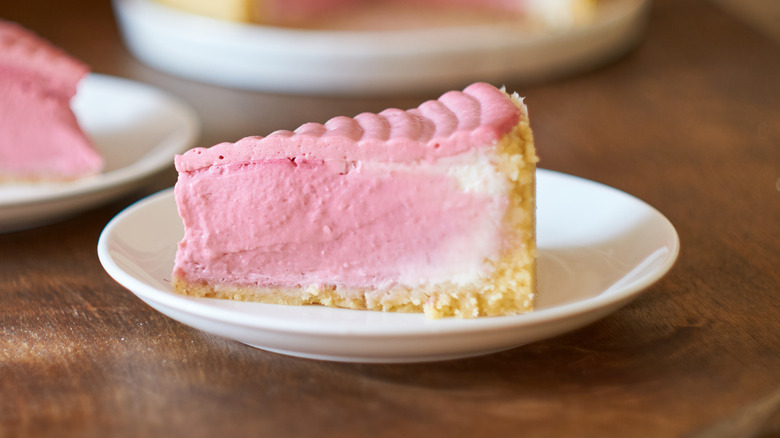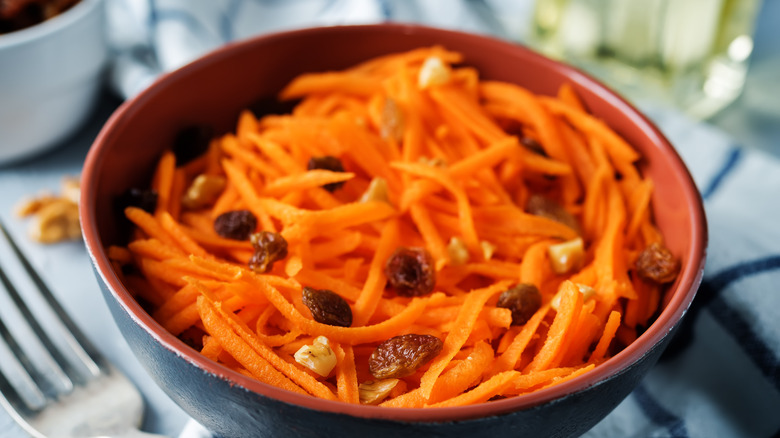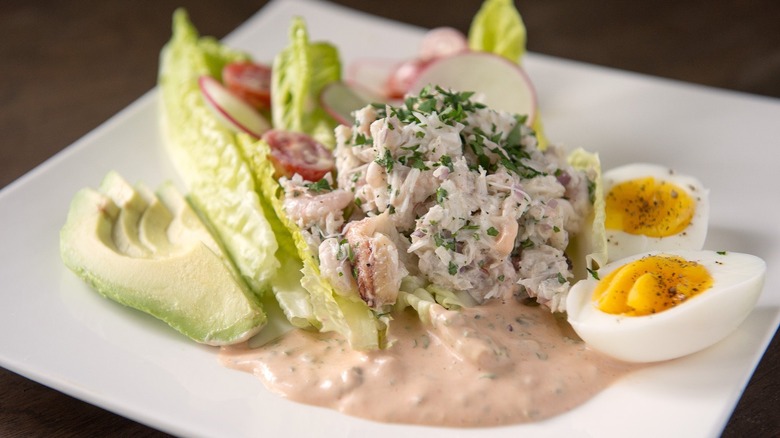13 Original Cheesecake Factory Items No Longer On The Menu - Exclusive
The Cheesecake Factory is now an international brand with over 200 restaurants, but like most empires, it kicked off with humble beginnings. In this case, that start was a single Beverly Hills, which opened in 1978. Much like the chain's global footprint, its menu used to be smaller than it is now. When it opened, the Beverly Hills location sold about 60 menu items (not including all the cheesecake flavors). The current number is somewhere in the realm of 250. The chain doesn't just keep all of its previous recipes intact while adding new stuff — it retires old offerings to make room for fresh ideas.
The company sent us the menu from the original restaurant, and almost nothing offered then sold by the chain today. Even the items that are still available have been changed in the intervening 45 years (except the original cheesecake — that's still exactly the same). We used the original Cheesecake Factory menu and an exclusive interview with the chain's executives to bring you the backstory of these discontinued menu items. Here are some highlights from The Cheesecake Factory's menu graveyard.
1. Omelette Mexicana
Omelettes have been a cornerstone of The Cheesecake Factory's menu since the very beginning. According to our interview with The Cheesecake Factory executives, "Omelettes were very popular. They were available for breakfast, lunch & dinner –- just as they are today."
These days, there are three omelette varieties on the menu: a California omelette with a bunch of veggies; a spinach, mushroom, bacon, and cheese omelette, and a create-your-own option. Back in 1978, the restaurant offered an extensive menu of speciality omelettes. The most intriguing one to our modern eyes is the Omelette Mexicana, an attempt to add some South-of-the-border flair to the egg dish. It included Ortega chiles (the fire roasted canned green variety which you can still buy today), Monterey Jack, tomatoes, and sour cream. This sounds like it would be a very satisfying meatless egg dish, with the chiles adding some mild spice and the sour cream and cheese making the omelette rich and melty. The relative ease of sourcing these ingredients and cooking an omelette make this a good option to prepare at home if you'd like to taste the historical Cheesecake Factory menu.
If you're looking for Mexican-inspired breakfasts at the modern Cheesecake Factory, you have options, though not in the omelette section. Seek out the breakfast burrito or Factory Huevos Rancheros for a little Mexican spice.
2. Adam's Favorite
One quirk of the early Cheesecake Factory menu was that many of the dishes were named after people. This was a cute way for the original team to shout out friends and family, but of course, it meant you didn't get any clues about what the dish was from its name. It seems as though someone on staff named Adam liked ice cream, as Adam's Favorite was a cream puff stuffed with vanilla ice cream and topped with hot fudge and whipped cream. (Today, you'll find Adam's Peanut Butter Cup Fudge Ripple cheesecake on the menu.) Apparently, Cheesecake Factory founder David Overton liked this dish as well, because it was inspired by something he enjoyed as a kid. Per The Cheesecake Factory executives, "The Adam's Favorite hot fudge cream puff was similar to a cream puff David grew up eating at Sander's in Detroit."
This was a dessert with a complex interplay of temperatures and textures — crisp pastry, soft whipped cream, cold ice cream, and hot fudge. It was listed on the menu's Ice Cream Delights section, which was a great deal longer in 1978 than it is nowadays. Back in the '70s, you could order several variations of ice cream sundaes and milkshakes, an ice cream-topped Belgian waffle, and even a classic banana split.
3. Renee's Special
Renee's Special, named after the sister of Cheesecake Factory founder David Overton, is another Ice Cream Delight. It's described on the menu as "broiled fresh pineapple with cinnamon and brown sugar." Given that it's in the ice cream section of the menu, we assume it came topped with a scoop as well.
Although gluten-free diets weren't on the radar in 1978 like they are now, this would have been a good option for any restaurant guests who couldn't eat wheat flour. It's a great hot-and-cold combination, with the warm broiled pineapple softening the ice cream. Unlike Adam's favorite, it would be pretty easy to make at home. You would just need to cut up a fresh pineapple and either put it under the broiler with cinnamon and sugar or use a torch to brûlée it. You could even do something similar with grilled pineapple if you wanted a smoky element. This would be a great light-ish dessert for a grilled meal in the summertime. Although Renee's Special is no more, her name lives on in the Renee's Chicken-Almond Salad Sandwich and Renee's Fresh Turkey Sandwich from the present-day Cheesecake Factory menu.
4. Quiche
Brunch dishes were quite popular early in The Cheesecake Factory's history. In addition to omelettes, quiche was a big seller at the first location. The menu only lists a quiche of the day, but per our interview, quiche Lorraine was always available as well. The quiche was accompanied by fruit and a tossed salad. At $3.95, it was one of the priciest items on the menu; only dishes made with expensive seafood like crab Louie or the crab, avocado, and cheese omelet cost more money. Apparently, quiche must have seemed fancy to diners in '70s Beverly Hills.
There's nothing so refined and European as quiche on Cheesecake Factory's present-day brunch menu. If you want to fancy it up at brunch, your best option today is probably one of the chain's eggs Benedict variations. The good news for you is that we have a quiche Lorraine recipe that will allow you to whip up this classic with relative ease. You can even take a shortcut and use store-bought pie crust if you'd like.
5. Roasted chicken
The Specialties section of the 21st-century Cheesecake Factory menu is littered with chicken dishes. Many of them are deep-fried, which would not have been an option at the first location. As the executives told us, David Overton "didn't know how to use a deep fryer," so there was no fried food at the first Cheesecake Factory. However, he did know how to roast a chicken.
The roasted chicken came with two salads of the customer's choice. The salad selection was extensive, ranging from comfort classics like coleslaw and potato salad to fancier options like marinated artichokes. Interestingly, you could order the chicken hot or cold. We understand eating cold roast chicken at home if you're pulling leftovers out of the fridge and don't want to bother with heating them up, but at a restaurant? We just can't imagine choosing cold poultry over a juicy, succulent, warm, fresh-from-the-oven bird.
6. Hamburger steak
We're not exactly sure when The Cheesecake Factory started calling its burgers by the copyright-protected term "Glamburgers," but it wasn't using that word in 1978. The executives told us that The Factory Burger with grilled onions, tomato, and either Monterey Jack or cheddar was a customer favorite in the early days. If you added cheese to the Classic Burger, you could eat something very similar at The Cheesecake Factory today, though you no longer have the choice to order it king size on a freshly-baked loaf of sourdough bread like you could in the '70s.
While most of the 1978-era specialty burgers look good to us, one sticks out as a bit odd: the hamburger steak. It's not that we can't get down with a bunless burger; we love a good Salisbury steak. The grilled onions, tomatoes, and salad are all fine by us too — there's just one accouterment in this dish that seems a bit out of place: cottage cheese. Do you dump the cottage cheese on top of the burger patty and use it as a kind of sauce? Is it meant to be eaten on its own? It confuses us.
Our theory is that this entrée was meant as a high-protein, healthy choice. Cottage cheese is a favorite of dieters, and that fact combined with the lack of bun in this dish leads us to our hypothesis. From a culinary perspective, however, we're not sold.
7. Stuffed tomato or avocado
The Cheesecake Factory team sent us some archival photos from the original location, but they didn't include any pictures of this dish, which is unfortunate because it sounds like it was quite visually impressive. Per The Cheesecake Factory executives, the stuffed tomatoes and avocados "were served on big leaves of lettuce in huge white plastic bowls shaped like seashells and had a really dramatic presentation." They would have been perfect for Instagram had they stuck around into the 21st century.
You could get your avocado or tomato stuffed with a variety of creamy salads: tuna, chicken, egg, or crab. If you chose the crab salad, you were really balling out; at $4.95, it was tied with Sharon's Favorite (another avocado and crab dish) as the second-most-expensive item on the menu.
The early Cheesecake Factory menu was loaded with avocado dishes, perhaps because of its California roots (California accounts for the majority of U.S. avocado production). In addition to the stuffed avocados, there was also the Beverly Hills burger with avocado, a shrimp and avocado salad, and Avocado Delights sandwiches. The Cheesecake Factory's tradition of creative avocado applications continues to the present day with dishes like avocado egg rolls.
8. Wyoming Humdinger
Now we're back to dishes with names that don't tell you anything about their actual contents. Like Adam's Favorite, this one was inspired by David Overton's childhood in Detroit. (No, Detroit is not in Wyoming, and no, we don't know why it's called a Wyoming Humdinger.) According to our sources at The Cheesecake Factory, the Wyoming Humdinger was based on a menu item from Darby's, which was a Jewish deli that was popular in Detroit when Overton was growing up.
This sandwich definitely shows its Jewish deli roots, with layers of corned beef, pastrami, or roast beef (customer's choice) topped with Swiss cheese, coleslaw, and Thousand Island dressing. It was featured in the Unusual sub-section of the sandwich menu alongside another corned beef or pastrami creation: the Dinty Moore, which was a triple-decker club-style sandwich. You could also order plain sandwiches with corned beef or pastrami on their own.
Although you can still get a cold-cut sandwich at The Cheesecake Factory, most of the modern selections are poultry-based. Jewish-style meats like pastrami and corned beef have been trimmed from the menu.
9. Oscar's Special
Many of the items we've highlighted so far were best-sellers at the original Beverly Hills Cheesecake Factory, but Oscar's Special was the opposite. As the executives told us, "While David [Overton's] father, Oscar, loved sardines, many other people didn't — so Oscar's Special sardine sandwich didn't last very long on the menu."
Judging by the menu description, this was a very pungent sandwich. Sardines already bring a lot of oily, fishy funk to the party, and Oscar's Special combined them with cream cheese, lettuce, tomatoes, and onions. Between the sardines, cheese, and onions, you'd probably want to brush your teeth before returning to work if you ate this on your lunch break. This was the only sandwich on the menu that came served on a bagel by default.
While we can understand why Overton would want to give his dad his own special menu item, we can also see why this sandwich wasn't a runaway hit. We hope Oscar didn't take it too personally when this sandwich got axed from the menu.
10. Evelyn's Favorite
Although David Overton was the one who started The Cheesecake Factory restaurant, his mother Evelyn was the reason the business existed in the first place. The famous cheesecake is made using her recipe, and before the restaurant opened, she ran a wholesale dessert business. Her son originally conceived of the restaurant as a way to sell more cheesecake.
It seems as though diners were more receptive towards Evelyn's namesake sandwich than her husband's (or at least it wasn't singled out by The Cheesecake Factory executives as a flop). Evelyn's Favorite was a light, vegetarian creation that wouldn't have looked out of place on the menu of a 1970s Californian health-food café — it was basically a salad on bread, combining avocado, mushrooms, alfalfa sprouts, cucumbers, tomatoes, and cream cheese. Sunflower seeds added some crunch. If you took out the cream cheese, it would even be vegan.
Although the modern Cheesecake Factory is more known for decadence than diet-friendly food, there are still healthy options if you know where to look. In 2011, the chain debuted the SkinnyLicious menu of lighter appetizers and entrees.
11. Pink Squirrel cheesecake
At heart, The Cheesecake Factory was, and still is, all about its signature dessert. The restaurant opened with 30 cheesecake varieties on the dessert menu, and you'll find even more than that today. However, most of the flavors on the old menu are long since gone. The one that intrigued us the most was Pink Squirrel.
A Pink Squirrel is a rich, sweet, chocolaty cocktail made by shaking heavy cream, creme de cacao, and creme de noyaux together and garnishing the sweet concoction with nutmeg. A product of 1940s Milwaukee, the drink is out of step with modern cocktail culture and doesn't show up on menus much these days. Part of that is due to the rarity of creme de noyaux, a fruit pit-flavored liqueur that's difficult to find. The insect-based cochineal dye in the creme de noyaux gives the drink its signature pink color.
We're betting the Pink Squirrel cheesecake was a pink-colored cacao, noyaux, and nutmeg-flavored dessert. It was joined on the menu by other booze-inspired cheesecakes, including piña colada, creme de menthe, amaretto, and Grand Marnier. While Cheesecake Factory was hiding a whole liquor cabinet in its dessert case back then, the current cheesecake lineup veers away from the booze inspiration.
12. Carrot-raisin salad
Can you name a more iconic duo than carrots and raisins? Our answer is yes. Of course, carrot cake is sometimes studded with raisins, but the idea of eating a pile of dried fruit and shredded root vegetables as a side dish sounds a little strange to us. Despite our opinions on the matter, carrot-raisin salad was part of The Cheesecake Factory's original salad roster.
It seems as though The Cheesecake Factory wasn't the only establishment that sold this concoction. It's something of an old-time classic, and Chick-fil-A served it until about a decade ago. That chain's version upped the sweetness factor by adding canned crushed pineapple to the carrot slaw and raisins. To finish, everything was tossed in a sweet-and-sour mayo-based dressing. Yum?
If you want to try a fruit-less version of the salad that might cater to more modern palates, consider our carrot slaw recipe. It goes in a slightly more savory direction with red onion, cabbage, and Dijon mustard.
13. Shrimp or crab Louie
You were truly living it up if you ordered crab Louie at The Cheesecake Factory in 1978. It was comfortably the priciest item on the menu, ringing it at $5.95. That works out to $27.54 in 2023 money, which is a lot to pay for what is essentially a light salad dish (even if it contains heaping helpings of crabmeat). Slightly more frugal diners could opt for shrimp Louie instead, which was $1.20 cheaper.
Louie is cooked, cooled seafood tossed in a mixture of mayonnaise, ketchup, pickle relish, olives, and onions, then served on lettuce leaves. The exact ingredients in the salad and dressing can vary slightly, but the mayo, ketchup, relish, and lettuce remain constant. It's super old-school — can you imagine a hip, modern seafood restaurant serving crab tossed in what basically amounts to gussied-up Thousand Island dressing? The Cheesecake Factory has modernized its seafood menu and no longer has room for crab Louie, but we bet it tasted great, as sacrilegious as the mixing of crab and ketchup might feel to us.
